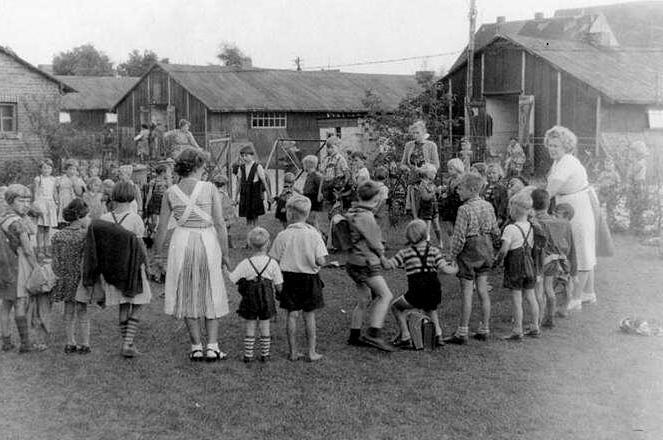
German Boys' Clothes: Post War 1940s

Figure 1.--This German photograph is undated. We believe it was taken in a camp for displaced persons (DPs) --notice the baracks style housing. The DPs were Germans expelled from the countries that had been occupied during the War (Czechoslovakia, Poland, and other countries). Many came from families that had lived in these countries since the Middle Ages. This ws the largest forced migration in history. Somehow the Germans without outdide help manage to care for the rfugees and integrate them into the economy in a remarkavly short time.
|
|
Living conditiond throughout Germany were very severe during the last monts of the War and the post-War 1940s. The ground combat and strategic bombing campaign had destroyed Germany's cities along with the country's industrial and tranportation infrastructure. The War's aftermath was devestating. The Germans in the cities were close to starvation, a condition that the NAZIs had imposed on the subject people in the occupied countries during the War. Even after the Allies restored some semblance of order, food was very dcrce. And as the the concentration camps and labor camps were cleared out and the displaced people headed home, several million Germans from the East and Balkans entrered Germany. Many had fled west was the Wehrmacht retreated from the advancing Red Army. Other were expelled or driven out of the liberated countries by the new governments. German families also had little money available for clothing of any kind. Supplies were limited. Boys wore what ever clothes they had as long as possible. You see many boys wearing outgrown clothing. New purchases when possible were only of very practical items. Many children went barefoot. Shoes in particular were in short supply. The clothing available on the black market was very expensive. This did not begin to change until the Marshall Plan was introduced in 1948, at least in West Germany. The United States offered Marshall Plan aid to the Soviets, East Germans and other Soviet sattelites, but Stalin rejected the offer. The Soviets in East Germany were still dismantlng factories and shipping them East, adding to the economic distress. The austere situation in Germany did not begin to change until the American Marshall plan was approved and the West Germans instituted a currency reform, launching the German Economic Miracle.
HBC

Navigate the Boys' Historical Clothing German pages:
[Return to the Main German post-War decade page]
[Return to the Main German page]
[German choirs]
[German scouts]
[German school uniforms]
[German royalty]
[German sailor suits]
[German ethnic]
[Lederhosen]
[Tights]
[Long stockings]
Navigate the Boys' Historical Clothing Web Site:
[Introduction]
[Activities]
[Biographies]
[Chronology]
[Clothing styles]
[Countries]
[Bibliographies]
[Contributions]
[FAQs]
[Glossaries]
[Images]
[Links]
[Registration]
[Tools]
[Boys' Clothing Home]
Created: 10:55 PM 11/7/2011
Last updated: 10:55 PM 11/7/2011



